Structural basis of a nucleosome containing histone H2A.B/H2A.Bbd that transiently associates with reorganized chromatin
- PMID: 24336483
- PMCID: PMC3863819
- DOI: 10.1038/srep03510
Structural basis of a nucleosome containing histone H2A.B/H2A.Bbd that transiently associates with reorganized chromatin
Erratum in
-
Corrigendum: Structural basis of a nucleosome containing histone H2A.B/H2A.Bbd that transiently associates with reorganized chromatin.Sci Rep. 2015 Jul 13;5:9628. doi: 10.1038/srep09628. Sci Rep. 2015. PMID: 26166249 Free PMC article. No abstract available.
Abstract
Human histone H2A.B (formerly H2A.Bbd), a non-allelic H2A variant, exchanges rapidly as compared to canonical H2A, and preferentially associates with actively transcribed genes. We found that H2A.B transiently accumulated at DNA replication and repair foci in living cells. To explore the biochemical function of H2A.B, we performed nucleosome reconstitution analyses using various lengths of DNA. Two types of H2A.B nucleosomes, octasome and hexasome, were formed with 116, 124, or 130 base pairs (bp) of DNA, and only the octasome was formed with 136 or 146 bp DNA. In contrast, only hexasome formation was observed by canonical H2A with 116 or 124 bp DNA. A small-angle X-ray scattering analysis revealed that the H2A.B octasome is more extended, due to the flexible detachment of the DNA regions at the entry/exit sites from the histone surface. These results suggested that H2A.B rapidly and transiently forms nucleosomes with short DNA segments during chromatin reorganization.
Figures
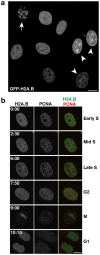
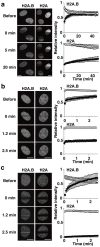
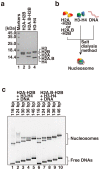
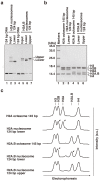
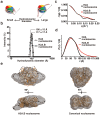
Similar articles
-
Structural analysis of the hexasome, lacking one histone H2A/H2B dimer from the conventional nucleosome.Biochemistry. 2012 Apr 17;51(15):3302-9. doi: 10.1021/bi300129b. Epub 2012 Apr 2. Biochemistry. 2012. PMID: 22448809
-
Histone variant H2A.B-H2B dimers are spontaneously exchanged with canonical H2A-H2B in the nucleosome.Commun Biol. 2021 Feb 12;4(1):191. doi: 10.1038/s42003-021-01707-z. Commun Biol. 2021. PMID: 33580188 Free PMC article.
-
The N-terminal and C-terminal halves of histone H2A.Z independently function in nucleosome positioning and stability.Genes Cells. 2020 Aug;25(8):538-546. doi: 10.1111/gtc.12791. Epub 2020 Jul 22. Genes Cells. 2020. PMID: 32500630 Free PMC article.
-
Quickly evolving histones, nucleosome stability and chromatin folding: all about histone H2A.Bbd.Gene. 2008 Apr 30;413(1-2):1-7. doi: 10.1016/j.gene.2008.02.003. Epub 2008 Feb 16. Gene. 2008. PMID: 18329190 Review.
-
Patterning chromatin: form and function for H2A.Z variant nucleosomes.Curr Opin Genet Dev. 2006 Apr;16(2):119-24. doi: 10.1016/j.gde.2006.02.005. Epub 2006 Feb 28. Curr Opin Genet Dev. 2006. PMID: 16503125 Review.
Cited by
-
H2A.Z controls the stability and mobility of nucleosomes to regulate expression of the LH genes.Nat Commun. 2016 Sep 22;7:12958. doi: 10.1038/ncomms12958. Nat Commun. 2016. PMID: 27653784 Free PMC article.
-
Distinct features of the histone core structure in nucleosomes containing the histone H2A.B variant.Biophys J. 2014 May 20;106(10):2206-13. doi: 10.1016/j.bpj.2014.04.007. Biophys J. 2014. PMID: 24853749 Free PMC article.
-
Casting histone variants during mammalian reproduction.Chromosoma. 2023 Sep;132(3):153-165. doi: 10.1007/s00412-023-00803-9. Epub 2023 Jun 22. Chromosoma. 2023. PMID: 37347315 Free PMC article. Review.
-
Incorporation and influence of Leishmania histone H3 in chromatin.Nucleic Acids Res. 2019 Dec 16;47(22):11637-11648. doi: 10.1093/nar/gkz1040. Nucleic Acids Res. 2019. PMID: 31722422 Free PMC article.
-
A new link between transcriptional initiation and pre-mRNA splicing: The RNA binding histone variant H2A.B.PLoS Genet. 2017 Feb 24;13(2):e1006633. doi: 10.1371/journal.pgen.1006633. eCollection 2017 Feb. PLoS Genet. 2017. PMID: 28234895 Free PMC article.
References
-
- Luger K., Mader A. W., Richmond R. K., Sargent D. F. & Richmond T. J. Crystal structure of the nucleosome core particle at 2.8 Å resolution. Nature 389, 251–260 (1997). - PubMed
-
- Davey C. A., Sargent D. F., Luger K., Maeder A. W. & Richmond T. J. Solvent mediated interactions in the structure of the nucleosome core particle at 1.9 Å resolution. J. Mol. Biol. 319, 1097–1113 (2002). - PubMed
-
- Kimura H. Histone dynamics in living cells revealed by photobleaching. DNA Repair 4, 939–950 (2005). - PubMed
Publication types
MeSH terms
Substances
LinkOut - more resources
Full Text Sources
Other Literature Sources
Molecular Biology Databases

